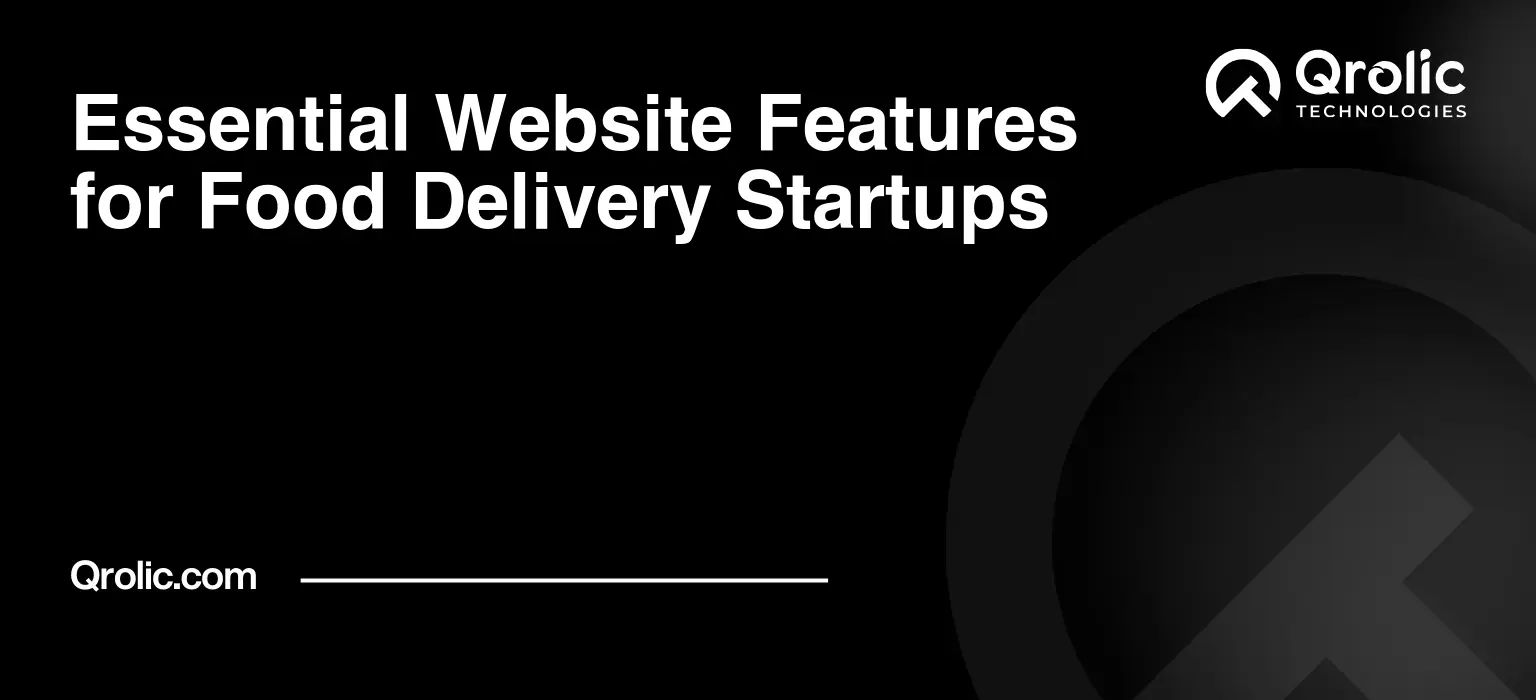Quick Summary:
- Your website is vital for food delivery success.
- Include essential features like easy ordering and payments.
- Enhance experience with loyalty programs and smart filters.
- Optimize your website with SEO to attract customers.
Table of Contents
- The Appetizing Foundation: Why a Stellar Website is Crucial for Food Delivery Startups
- Building Trust and Credibility from the First Click
- Driving Orders and Increasing Revenue: The Direct Link
- Streamlining Operations and Improving Efficiency: The Backbone of Your Business
- Core Functionality: The “Must-Have” Features for a Successful Food Delivery Website
- 1. Intuitive Menu Display: Tempting Customers with Visual Appeal
- 2. Seamless Online Ordering System: From Browse to Buy with Ease
- 3. Secure Payment Gateway Integration: Building Trust with Every Transaction
- 4. Real-Time Order Tracking: Keeping Customers Informed and Engaged
- 5. Customer Account Management: Fostering Loyalty and Repeat Business
- 6. Restaurant Integration: Connecting Your Platform to Local Eateries
- 7. Mobile Responsiveness: Reaching Customers on Any Device
- Enhancing the Experience: “Nice-to-Have” Features That Set You Apart
- 1. Advanced Search Filters: Helping Customers Find Exactly What They Crave
- 2. Integrated Customer Support: Providing Real-Time Assistance
- 3. Loyalty Programs and Rewards: Incentivizing Repeat Business
- 4. Personalized Recommendations: Guiding Customers to Discover New Favorites
- 5. Social Media Integration: Expanding Reach and Engagement
- 6. Delivery Driver Management System: Optimizing Delivery Operations
- 7. Data Analytics and Reporting: Making Informed Decisions
- SEO Optimization: Making Your Website Discoverable
- 1. Keyword Research: Understanding What Your Customers Are Searching For
- 2. On-Page Optimization: Optimizing Your Website Content
- 3. Off-Page Optimization: Building Authority and Reputation
- 4. Technical SEO: Ensuring Your Website is Crawlable and Indexable
- Qrolic Technologies: Your Partner in Building a Successful Food Delivery Platform
- Why Choose Qrolic Technologies?
- Our Services for Food Delivery Startups:
- Conclusion: Investing in Your Digital Future
The Appetizing Foundation: Why a Stellar Website is Crucial for Food Delivery Startups

In the fiercely competitive food delivery landscape, your website isn’t just an online presence; it’s your digital storefront, your primary point of contact, and the engine driving your business. A clunky, confusing, or unattractive website can send potential customers running straight to your competitors. This section explores the fundamental reasons why a robust and feature-rich website is absolutely essential for the success of your food delivery startup. We’ll cover key benefits and demonstrate how a well-designed website translates directly into increased orders and customer loyalty.
Building Trust and Credibility from the First Click
- First Impressions Matter: Your website is often the first interaction a potential customer has with your brand. A professional and well-designed site immediately conveys trustworthiness and reliability. It tells customers that you are a legitimate business that takes pride in its services.
- Showcasing Quality and Brand Identity: A visually appealing website allows you to showcase high-quality images of your food, highlight positive customer reviews, and effectively communicate your brand’s unique value proposition (e.g., organic ingredients, speedy delivery, diverse cuisine options).
- Transparency Builds Confidence: Providing clear information about your delivery area, pricing, menu options, and company policies fosters transparency and builds confidence in your service. This is especially important for new customers who are hesitant to try an unfamiliar delivery platform.
Driving Orders and Increasing Revenue: The Direct Link
- Seamless Online Ordering Experience: The primary function of your website is to facilitate online ordering. A smooth, intuitive, and user-friendly order system is paramount. Customers should be able to easily browse menus, customize their orders, securely make payments, and track their deliveries in real-time.
- 24/7 Availability: Your website allows customers to place orders at any time of day or night, expanding your reach beyond traditional business hours. This is a significant advantage over restaurants that rely solely on phone orders.
- Targeted Marketing and Promotions: Your website provides a platform to run targeted marketing campaigns, offer exclusive discounts, and promote special deals. This can attract new customers and incentivize repeat business.
Streamlining Operations and Improving Efficiency: The Backbone of Your Business
- Automated Order Management: A well-integrated website automates the entire order management process, from order placement to delivery confirmation. This reduces the risk of errors, frees up staff time, and improves overall efficiency.
- Centralized Communication Hub: Your website can serve as a centralized communication hub for customers, restaurants, and delivery drivers. This streamlines communication and ensures that everyone is on the same page.
- Data-Driven Insights: Your website collects valuable data about customer behavior, order patterns, and popular menu items. This data can be used to optimize your menu, improve your marketing strategies, and enhance the overall customer experience.
Core Functionality: The “Must-Have” Features for a Successful Food Delivery Website
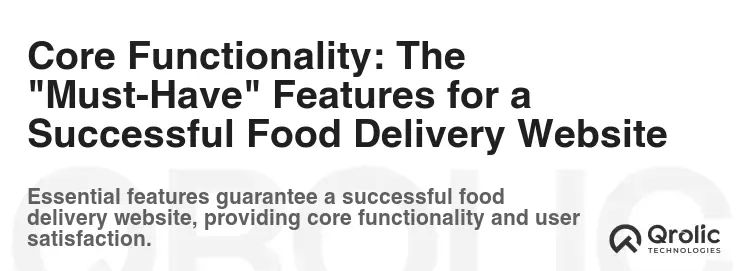
This section delves into the essential features that every food delivery startup website should incorporate. These features are not optional; they are the core building blocks of a successful online ordering platform. From a comprehensive menu display to secure payment processing, we’ll cover each critical component in detail.
1. Intuitive Menu Display: Tempting Customers with Visual Appeal
- High-Quality Food Photography: Mouthwatering photos are non-negotiable. Invest in professional food photography that showcases your dishes in the best possible light.
- Detailed Menu Descriptions: Provide clear and concise descriptions of each menu item, including ingredients, preparation methods, and potential allergens.
- Categorized Menu Organization: Group menu items into logical categories (e.g., appetizers, entrees, desserts, beverages) to make browsing easier.
- Search Functionality: Allow users to easily search for specific dishes or ingredients.
- Customization Options: Enable customers to customize their orders with options for toppings, sides, and special instructions.
- Nutritional Information (Optional): Providing nutritional information can appeal to health-conscious customers.
- Allergen Information (Essential): Clearly identify potential allergens in each dish to protect customers with dietary restrictions.
2. Seamless Online Ordering System: From Browse to Buy with Ease
- Easy Navigation: The ordering process should be simple and intuitive, with clear calls to action and minimal steps.
- Shopping Cart Functionality: Allow users to add multiple items to their cart and review their order before checkout.
- Order Customization: Provide options for special requests, dietary restrictions, and additional instructions.
- Guest Checkout Option: Allow users to place orders without creating an account (although creating an account should be encouraged).
- Order Tracking: Provide real-time order tracking so customers can see the status of their delivery.
- Re-Ordering: Allow customers to easily re-order previous meals with just a few clicks.
- Clear Pricing and Fees: Display all prices, taxes, and delivery fees upfront.
3. Secure Payment Gateway Integration: Building Trust with Every Transaction
- SSL Encryption: Ensure that your website is secured with SSL encryption to protect sensitive customer data.
- Multiple Payment Options: Offer a variety of payment options, including credit cards, debit cards, and popular digital wallets (e.g., PayPal, Apple Pay, Google Pay).
- PCI Compliance: Ensure that your payment gateway is PCI compliant to protect against fraud.
- Secure Storage of Payment Information (Optional): If you offer the option to save payment information, ensure that it is stored securely in accordance with industry best practices.
- Clear Refund and Cancellation Policies: Clearly communicate your refund and cancellation policies to build trust with customers.
4. Real-Time Order Tracking: Keeping Customers Informed and Engaged
- Map Integration: Integrate a map that shows the location of the delivery driver in real-time.
- Order Status Updates: Provide regular updates on the status of the order (e.g., “Order Received,” “Preparing Food,” “Out for Delivery,” “Delivered”).
- Estimated Delivery Time: Provide an accurate estimated delivery time and update it as needed.
- Push Notifications (Optional): Send push notifications to customers to keep them informed about the status of their order.
- Driver Contact Information (Optional): Provide the customer with the option to contact the delivery driver directly (while protecting the driver’s privacy).
5. Customer Account Management: Fostering Loyalty and Repeat Business
- Easy Account Creation: Make it simple for customers to create an account.
- Order History: Allow customers to view their past orders.
- Saved Addresses: Allow customers to save their delivery addresses for faster checkout.
- Payment Information Management: Allow customers to manage their saved payment information.
- Profile Management: Allow customers to update their profile information, such as their name, email address, and phone number.
- Rewards Program Integration: Integrate your customer loyalty program into the account management system.
6. Restaurant Integration: Connecting Your Platform to Local Eateries
- Restaurant Profiles: Create dedicated profiles for each restaurant, showcasing their menu, hours of operation, and contact information.
- Automated Order Routing: Automatically route orders to the correct restaurant.
- Order Confirmation and Tracking: Provide restaurants with real-time order confirmation and tracking.
- Menu Management Tools: Provide restaurants with tools to easily update their menu and pricing.
- Communication Portal: Provide a communication portal for restaurants to communicate with your staff.
7. Mobile Responsiveness: Reaching Customers on Any Device
- Responsive Design: Ensure that your website is fully responsive and adapts to different screen sizes and devices.
- Mobile-First Approach: Consider designing your website with a mobile-first approach to optimize the user experience for mobile devices.
- Fast Loading Times: Optimize your website for speed to ensure a fast and seamless experience on mobile devices.
Enhancing the Experience: “Nice-to-Have” Features That Set You Apart
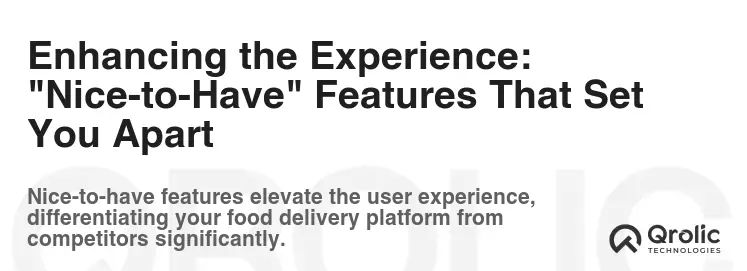
While the core features outlined above are essential, incorporating these “nice-to-have” features can significantly enhance the user experience and give your food delivery startup a competitive edge. These features go beyond basic functionality and focus on providing added value to customers and streamlining internal operations.
1. Advanced Search Filters: Helping Customers Find Exactly What They Crave
- Dietary Restrictions: Allow users to filter by dietary restrictions (e.g., vegetarian, vegan, gluten-free).
- Cuisine Type: Allow users to filter by cuisine type (e.g., Italian, Chinese, Mexican).
- Price Range: Allow users to filter by price range.
- Delivery Time: Allow users to filter by estimated delivery time.
- Restaurant Rating: Allow users to filter by restaurant rating.
- Specific Ingredients: Allow users to search for dishes containing (or excluding) specific ingredients.
2. Integrated Customer Support: Providing Real-Time Assistance
- Live Chat: Integrate a live chat feature to provide instant support to customers.
- FAQ Section: Create a comprehensive FAQ section to answer common questions.
- Contact Form: Provide a contact form for customers to submit inquiries.
- Phone Support: Provide a phone number for customers who prefer to speak to a representative.
3. Loyalty Programs and Rewards: Incentivizing Repeat Business
- Points-Based System: Award points for every order and allow customers to redeem points for discounts.
- Tiered Rewards Program: Offer different levels of rewards based on customer spending.
- Referral Program: Reward customers for referring new customers.
- Birthday Rewards: Offer special discounts or promotions on customers’ birthdays.
- Exclusive Deals for Loyalty Members: Provide exclusive deals and promotions to loyalty program members.
4. Personalized Recommendations: Guiding Customers to Discover New Favorites
- Order History-Based Recommendations: Recommend dishes based on the customer’s past orders.
- Popular Item Recommendations: Recommend popular items from local restaurants.
- New Restaurant Recommendations: Recommend new restaurants that the customer might be interested in.
- Location-Based Recommendations: Recommend restaurants based on the customer’s location.
- Time-Based Recommendations: Recommend dishes that are popular at the current time of day.
5. Social Media Integration: Expanding Reach and Engagement
- Social Sharing Buttons: Allow users to easily share their favorite dishes and restaurants on social media.
- Social Login: Allow users to create an account using their social media credentials.
- Social Feed Integration: Integrate your social media feed into your website.
- Social Contests and Giveaways: Run social media contests and giveaways to promote your food delivery startup.
6. Delivery Driver Management System: Optimizing Delivery Operations
- Driver Tracking: Track the location of delivery drivers in real-time.
- Route Optimization: Optimize delivery routes to minimize delivery times.
- Driver Communication: Provide a communication portal for drivers to communicate with your staff.
- Performance Tracking: Track driver performance metrics, such as delivery time and customer satisfaction.
- Automated Dispatch: Automatically assign orders to available drivers.
7. Data Analytics and Reporting: Making Informed Decisions
- Sales Reports: Track sales trends and identify top-selling menu items.
- Customer Behavior Analytics: Analyze customer behavior to understand their preferences and needs.
- Marketing Campaign Performance: Track the performance of your marketing campaigns to optimize your spending.
- Operational Efficiency Metrics: Track operational efficiency metrics, such as delivery time and order fulfillment rate.
SEO Optimization: Making Your Website Discoverable

A fantastic website is useless if nobody can find it. This section focuses on Search Engine Optimization (SEO) – the process of optimizing your website to rank higher in search engine results. By implementing these strategies, you can increase your website’s visibility and attract more organic traffic.
1. Keyword Research: Understanding What Your Customers Are Searching For
- Identify Relevant Keywords: Use keyword research tools to identify the keywords that your target audience is using to search for food delivery services. Some popular tools include Google Keyword Planner, Ahrefs, and SEMrush. Focus on keywords like “food delivery website,” “order system,” and “restaurant integration” along with location-specific terms (e.g., “food delivery [city name]”).
- Long-Tail Keywords: Target long-tail keywords (longer, more specific phrases) to attract highly targeted traffic. For example, instead of just “food delivery,” target “best pizza delivery in [neighborhood].”
- Competitor Analysis: Analyze your competitors’ websites to see which keywords they are targeting.
2. On-Page Optimization: Optimizing Your Website Content
- Title Tags: Optimize your title tags to include relevant keywords. The title tag is the text that appears in the search engine results page (SERP).
- Meta Descriptions: Write compelling meta descriptions that encourage users to click on your website. The meta description is the snippet of text that appears below the title tag in the SERP.
- Header Tags (H1-H6): Use header tags to structure your content and highlight important keywords.
- Image Alt Text: Add descriptive alt text to all of your images. Alt text is the text that appears if an image cannot be displayed.
- Content Optimization: Write high-quality, informative content that is relevant to your target audience and includes relevant keywords. Use keywords naturally within your content, avoiding keyword stuffing.
- Internal Linking: Link to other relevant pages on your website.
- URL Structure: Use clear and concise URLs that include relevant keywords.
3. Off-Page Optimization: Building Authority and Reputation
- Link Building: Acquire high-quality backlinks from other reputable websites. Backlinks are links from other websites to your website.
- Local Citations: Create local citations on online directories, such as Yelp and Google My Business.
- Social Media Marketing: Promote your website on social media platforms.
- Online Reviews: Encourage customers to leave positive reviews on online review sites.
4. Technical SEO: Ensuring Your Website is Crawlable and Indexable
- Website Speed: Optimize your website for speed. A slow website can negatively impact your search engine ranking.
- Mobile-Friendliness: Ensure that your website is mobile-friendly.
- XML Sitemap: Create an XML sitemap to help search engines crawl your website.
- Robots.txt File: Use a robots.txt file to tell search engines which pages on your website should not be crawled.
- Schema Markup: Implement schema markup to provide search engines with more information about your website content.
Qrolic Technologies: Your Partner in Building a Successful Food Delivery Platform
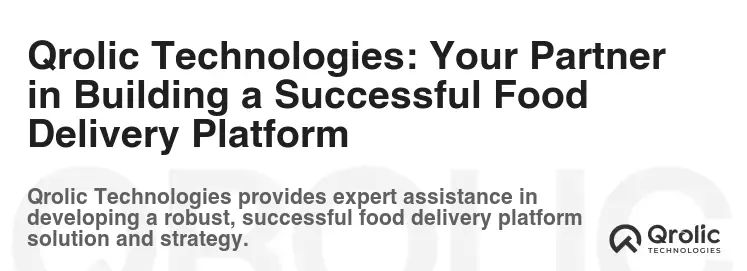
Qrolic Technologies (https://qrolic.com/) is a leading provider of custom software development services, specializing in building robust and scalable solutions for the food delivery industry. We understand the unique challenges faced by food delivery startups and offer a comprehensive suite of services to help you succeed.
Why Choose Qrolic Technologies?
- Expertise in Food Delivery Software Development: We have a proven track record of developing successful food delivery platforms for businesses of all sizes.
- Customized Solutions: We tailor our solutions to meet your specific needs and requirements. We don’t offer one-size-fits-all packages; we build a platform that reflects your unique brand and business model.
- Scalable and Reliable Architecture: We design our platforms to be scalable and reliable, ensuring that they can handle the demands of a growing business.
- Experienced Team: Our team of experienced developers, designers, and project managers are dedicated to delivering high-quality solutions on time and within budget.
- Comprehensive Support: We provide comprehensive support and maintenance services to ensure that your platform is always running smoothly.
Our Services for Food Delivery Startups:
- Website and Mobile App Development: We develop custom websites and mobile apps for iOS and Android platforms, incorporating all the essential features mentioned above.
- Order Management System Development: We build robust and scalable order system that streamline the order management process.
- Restaurant Integration Development: We integrate your platform with local restaurants, allowing them to easily manage their menus and orders.
- Payment Gateway Integration: We integrate secure payment gateways to protect customer data and ensure seamless transactions.
- Delivery Driver Management System Development: We develop a comprehensive delivery driver management system to optimize delivery operations.
- SEO and Digital Marketing Services: We provide SEO and digital marketing services to help you increase your website’s visibility and attract more customers.
- Ongoing Maintenance and Support: We offer ongoing maintenance and support to ensure your platform remains secure, reliable, and up-to-date.
Contact Qrolic Technologies today to discuss your food delivery startup’s needs and learn how we can help you build a successful online platform.
Conclusion: Investing in Your Digital Future
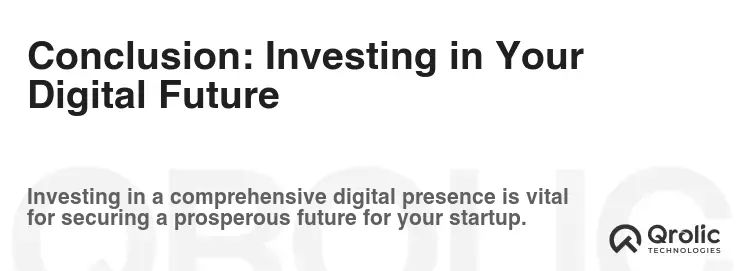
In today’s digital age, a strong online presence is not just an advantage; it’s a necessity for survival. For food delivery startups, a well-designed and feature-rich website is the key to attracting customers, driving orders, and building a successful business. By investing in the right website features and SEO strategies, you can position your startup for long-term growth and success in the competitive food delivery market. Remember to prioritize the core functionalities, enhance the user experience with “nice-to-have” features, and optimize your website for search engines to maximize its reach and impact. Partnering with experienced technology providers like Qrolic Technologies can further streamline the process and ensure that your website is built to meet your specific needs and goals. Ultimately, the success of your food delivery startup hinges on your ability to create a seamless, user-friendly, and trustworthy online experience that keeps customers coming back for more.
